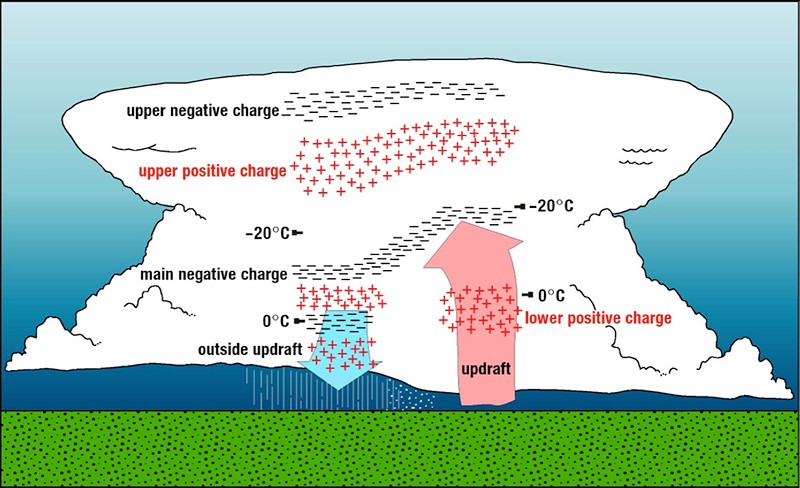Lightning, one of nature’s most dramatic displays, is a massive electrical discharge that occurs in the atmosphere. This awe-inspiring phenomenon, often seen during thunderstorms, is essentially a giant spark of electricity leaping between clouds, the air, or the ground. From ancient times, lightning has captivated and sometimes terrified humanity, and understanding its science reveals the fascinating power of atmospheric electricity.
The Science Behind the Spark: How Lightning Forms
In its initial stages, air acts as an insulator, separating areas of positive and negative charges within storm clouds and between the clouds and the ground. Think of it like a capacitor slowly building up energy. This charge separation is crucial to lightning formation. But what causes this charge separation?
Scientists believe that ice particles and water droplets within storm clouds play a key role. A leading theory involves graupel, which are soft hail particles. As graupel collides with smaller, supercooled ice crystals, an exchange of charge occurs. Typically, graupel becomes negatively charged, while the smaller ice crystals become positively charged. Due to updrafts within the storm, lighter, positively charged ice crystals are carried higher in the cloud, while heavier, negatively charged graupel remains lower. This process creates distinct charge regions within the cloud, building up a significant electrical potential.
When the electrical potential difference between these charge regions, or between the cloud and the ground, becomes strong enough to overcome the air’s insulating properties, a rapid discharge of electricity occurs – this is lightning. The path of lightning seeks the path of least resistance, ionizing the air as it travels at incredible speeds.
Types of Lightning: Intra-cloud and Cloud-to-Ground
Lightning manifests in various forms, but the two primary types are:
-
Intra-cloud Lightning (IC): This is the most common type, occurring within a single thunderstorm cloud. It happens between areas of opposite charges within the cloud itself. Often, IC lightning is observed as a flash illuminating the inside of a cloud, without a visible channel reaching the ground.
-
Cloud-to-Ground Lightning (CG): This is the type most familiar and potentially dangerous to us on the ground. CG lightning occurs between oppositely charged areas in the cloud and on the ground. Typically, the ground beneath a storm cloud becomes positively charged. A stepped leader, a channel of negative charge, descends from the cloud towards the ground in a series of jumps. As the stepped leader nears the ground, positive streamers rise from objects on the surface, such as trees, buildings, and even people. When a streamer connects with the stepped leader, a powerful return stroke surges upwards from the ground to the cloud, creating the bright flash we see and hear as thunder.
Thunder: The Sound of Lightning
Lightning and thunder are intrinsically linked; lightning always causes thunder. The immense energy discharged by a lightning bolt heats the air in its channel to incredibly high temperatures – around 50,000 degrees Fahrenheit (27,700 degrees Celsius), much hotter than the surface of the sun. This extreme heating causes the air to expand explosively, creating a shockwave that propagates outwards at supersonic speeds.
As this shockwave travels through the air, it weakens and becomes the sound wave we perceive as thunder. The sound of thunder can vary depending on the distance and the path of the lightning. Close lightning strikes often produce a sharp crack or bang followed by rumbles, while distant lightning may only be heard as a low rumble. This is because higher frequencies in the thunder sound are absorbed more quickly by the air over distance.
Conceptual model illustrating the distribution of electrical charges within storm clouds, showing distinct regions of positive and negative charge that contribute to lightning formation.
Estimating Distance: Lightning and Thunder as Nature’s Rulers
Because light travels much faster than sound, we see lightning almost instantaneously, while thunder arrives later. This time difference can be used to estimate the distance to a lightning strike.
By counting the seconds between seeing a lightning flash and hearing the thunder, you can approximate the distance. Sound travels approximately one mile in five seconds (or one kilometer in three seconds). Therefore, dividing the number of seconds by 5 gives you the distance in miles, and dividing by 3 gives the distance in kilometers. This “flash-to-bang” method is a simple yet effective way to gauge how far away lightning is and assess potential risks.
Where Lightning Strikes: Debunking Myths
While it’s true that taller objects like trees and skyscrapers are more likely to be struck by lightning compared to the surrounding ground, lightning strikes are not exclusively limited to the highest points. When a cloud-to-ground lightning flash is imminent, objects on the ground send up streamers to connect with the descending stepped leader. Taller objects are simply more likely to initiate these upward streamers.
However, lightning can and does strike the ground in open fields, even if taller objects are nearby. It’s crucial to remember that no place outdoors is entirely safe during a thunderstorm. Seeking shelter indoors or in a hard-topped vehicle is the safest course of action.
Ongoing Research: Unraveling the Mysteries of Lightning
Despite significant advancements in our understanding of lightning, it remains a complex and actively researched phenomenon. Scientists at institutions like the National Severe Storms Laboratory (NSSL) continue to investigate the intricate processes behind charge separation in clouds, the initiation of lightning strikes, and the detailed electrical structure of thunderstorms.
Researchers from the NSSL deploying a weather balloon equipped with instruments to gather data within thunderstorms, enhancing our comprehension of lightning and storm dynamics.
Using advanced tools like weather balloons equipped with electric field sensors, 3D cloud models, and field experiments such as the Thunderstorm Electrification and Lightning EXperiment (TELEX), researchers are constantly refining our knowledge of lightning. This ongoing research is vital for improving lightning safety, forecasting, and our overall appreciation of this powerful and beautiful natural phenomenon.
Further Reading:
- NOAA’s JetStream Online School for Weather: https://www.noaa.gov/jetstream
- NSSL Lightning Research: [Link to NSSL lightning research on what.edu.vn (replace with actual link)]
This article provides a comprehensive overview of what lightning is, delving into its formation, types, associated phenomena like thunder, and ongoing scientific investigations. By understanding the science behind lightning, we can better appreciate its power and take necessary precautions to stay safe during thunderstorms.

